

Sierra Wave
Newsletter
Volume 32, Number 4
March-April, 2014
Sierra Wave Newsletter
Volume 31, Number 4
March-April, 2013
Contents
- Events:
- Features:
- Reports/Announcements:
- Business
Events
April 24th: Kern County Big Year with Susan Steele
NOTE: We will have a pre-program COSA walk with the Audubon Board from 5:30-6:30 before this program. Meet at the west side (left as you face the building) of the USFS/BLM Building where the trailhead is at the back of the parking area, or wherever you see us gathering in that vicinity! We'll get to know each other as we stroll through the lovely COSA and look for birds along the way. If you are interested in helping out with your local "Little Audubon Chapter that Could," this is a perfect opportunity to discuss what you could contribute. Or just come to enjoy a pleasant late afternoon bird walk! Hope to see you there!!
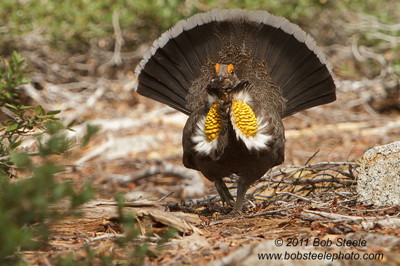
Sooty Grouse from Susan Steele's Kern County Big Year
Photo by Bob Steele
THURSDAY, April 24th, U.S. Forest Service/BLM Building in Bishop, 7:00-8:30pm
Our April program will be held at the U.S. Forest Service/BLM Building in Bishop on West Line Street, near the DMV. Our guest speaker, Susan Steele, will be giving a presentation on her Kern County Big Year. Doors open at 6:30, with the presentation starting at 7:00pm.
Kern County Big Year
From January 1st to December 31st 2011, Susan Steele did a Kern County big year. She set out to break the record for the greatest number of species of birds seen in Kern County in one year. Did she do it? Many of you know, and will enjoy hearing some of the details of that crazy year's adventure/slog. Others will have to come to the program to find out. We'll hear about some the many folks who helped, some of the serendipitous finds, and some of the species missed. There will also likely be some photos from Susan's husband, Bob Steele.
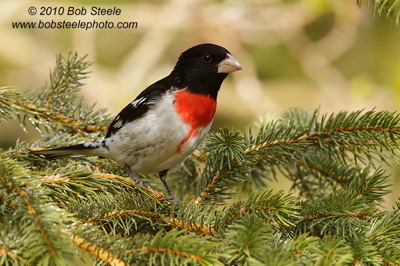
Rose-breasted Grosbeak from Susan Steele's Kern County Big Year
Photo by Bob Steele
Susan Steele's interest in birds began as a child in Idaho with evenings
spent on the porch listening to meadowlarks. This interest blossomed into a
passion when she moved to the California desert more than 30 years ago.
Recently she has taken to spending some of her free time in Aspendell, where
she enjoys hiking, looking at flowers, and chasing birds.
Please Note: This program falls on a THURSDAY, rather than our usual Wednesday night program.
Future Programs (schedule subject to change):
- April: Susan Steele on Susan's Kern County Big Year in 2011.
NOTE: We will have a pre-program COSA walk with the Audubon Board from 5:30-6:30 before this program.
- June (date and venue TBA): Matthew Matthiessen returns with a program on Birds of Brazil: Brazilian state of Mato Grosso
- Late September (Tentatively scheduled for Thursday, September 25th; venue TBA): Book Event with Marie Read, author of Sierra Wings: Birds of the Mono Lake Basin. Marie will speak about her new book and Spellbinder Books of Bishop will have books available for purchase (and signing) at the program.
- October (date and venueTBA): Leila Harris will present a Halloween-themed program on bat research and natural history.
Everyone is welcome to attend all programs!
Questions/comments: programs@esaudubon.org; 760-920-8541.
Back to Top
Upcoming ESAS Field Trips and Other Events
Monthly Bishop Paiute Tribe COSA, Bird Walk and Census
[Ed. Note: COSA walks are held on the second Saturday of every month, unless otherwise indicated]
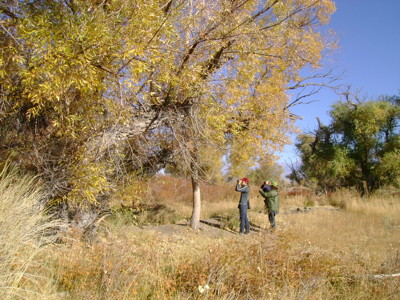
Birders at a COSA walk earlier this year
Our Conservation Open Space Area (COSA) Bird Walks and Censuses will be held on the second Saturdays of March and April (3/8 and 4/12) at 8:30am. Unless otherwise indicated, they will all be the second Saturday of the month, except for December, because we will have it coincide with the Christmas Bird Count. During June, July, August, and September they will start at 7:30 instead of 8:30.
The new Conservation Open Space Area is being developed for wildlife and the community by the Bishop Paiute Tribe. We'll be keeping species lists and observing behavior as well as identifying birds, for the purpose of creating bird lists for the site. Come and check out the new COSA and help census the birds that are using the area. For more information, read this article on the COSA in the March-April 2013 Sierra Wave newsletter. There have been surprises every month so far - come find out what new birds we'll see in March!
All are welcome - these walks are for birders of ALL LEVELS, beginners included! We will bring extra binoculars and field guides to share.
Please meet at 8:30am at the BLM/Forest Service Building on West Line Street in Bishop. Contact Hillary Behr for more information, or if you are interested in leading a future monthly walk: Hillary.behr@bishoppaiute.org or call (760) 920- 5287.
April's walk will be on Saturday, April 12th at 8:30am - watch the monthly email update, the field trips page on our website, or local media for confirmation, updates on leader(s) and meeting time. Or, contact Hillary (above), or if you just show up at 8 or so, you'll probably find us!
The Mono Basin Bird Chautauqua is June 20–22, 2014! Spaces in popular trips and events fill up quickly - register early for this great event. The Chautauqua features birding field trips and programs all day Friday and Saturday and Sunday morning with a picnic in the park on Sunday afternoon, featuring year's musical guest Jelly Bread. The schedule of events should be available online soon - go to birdchautauqua.org for updates!
Back to Top
April 23, Wednesday: 2014 Owens Lake Spring Big Day
The 2014 Owens Lake Spring Big Day will be Wednesday, April 23rd. We are looking for birders with at least some experience to help out in this intense bird census of Owens Lake. Contact Mike Prather to sign up. Small groups of citizen scientists will join with LADWP staff to spread across the lake and count EVERY BIRD WE FIND. Last April we had 115,000 birds! Owens Lake is an Audubon Important Bird Area (IBA) with tremendous importance. It hosts tens of thousands of shorebirds and waterfowl and is the largest nesting location for Snowy Plovers in California. Our data collected on Big Days is used by LADWP, State Lands, California Department of Fish and Wildlife, Great Basin Unified Air Pollution Control District, and Audubon in the management and planning at Owens Lake.
To join in, or for more information, please contact Mike Prather at 760-876-5807 or mprather@lonepinetv.com. We will meet at 7AM at the Diaz Lake parking lot three miles south of Lone Pine on Highway 395.
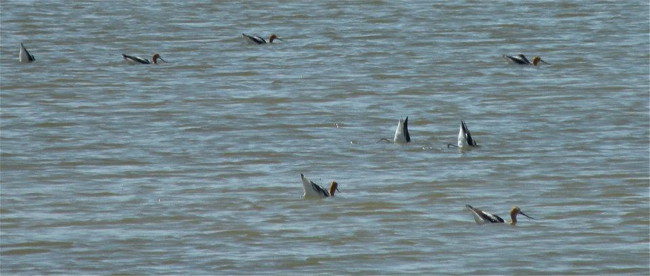
"Bottom's Up!"
American Avocets at an Owens Lake Spring Big Day, Photo by Michael Prather
Back to Top
April 26, Annual Audubon Yard Sale
We will be having the yard sale on Saturday April 26th at Sarah Sheehan's house, 2530 Sunset Drive. Please start saving your items to donate. All kinds of things are needed-they just need to be in good shape and working if they are electronic. If anyone can lend us some tables to put the items on it would be most appreciated! Drop off for items will be Friday April 25th at Sarah's house. Sarah may be also to accommodate other times as well-please call her at 760-920-8762 closer in time to the event.
The proceeds from the yard sale fund Audubon's conservation programs, birding in the classroom and our graduating senior scholarships and help pay for such expenses as meeting room rent, newsletter printing and mailing, and insurance.
In addition to needing items to sell, we need people to help set up and price on Friday and to work the sale on Saturday. Please call Roberta at 760-872-7846 if you can help us out with this important fundraiser. It is a LOT OF FUN setting up and selling!
Back to Top
May 17, Saturday: Mammoth Creek Birding; Leader, Ken Wells
Discover Warblers, Woodpeckers, and Hawks
with avid birdwatcher Ken Wells.
Walk along Mammoth Creek spotting springtime birds
and hearing their songs.
Meet at Mammoth Creek Park 8am.
Walk to Mammoth Museum, approximately 2 miles round trip from 8-11am.
Binoculars will be helpful.
For more info call Ken Wells 760-924-0013
Back to Top
Back to Top
Features
President’s Message
“Speed is irrelevant if you are headed in the wrong direction.”
— Mahatma Ghandi
I am interested by contrasts, looking to see what can be learned by juxtapositions. I am sure that is why I enjoy Roberta’s quilts so much; she is so good at contrasting colors and shapes. For that reason, the past couple of weeks have been a good experience for me. I started in Bishop, went to Palm Springs for a few days of spring/summer and then returned home to winter. Driving south brought us to a different season of the year; temperatures were nearly in the nineties. What are these birds? Imagine seeing Verdins everywhere, four kinds of hummingbirds wherever you look, and Vermillion Flycatchers that are a daily experience. The plants: I think the cactus gardens are enchanting and I long for the ability to have these shapes in my own landscape. When I return to Bishop, I will be reminded why that is not possible. The geology and landscape fascinates me. We visited a Palm Oasis which was an outdoor cathedral, and walked along a series of springs which demarked the San Andreas fault. It is so exciting to be in an environment in which mostly everything is a surprise and raises questions: what is that? How did that happen? What is going on there? This is so different! What do I like more?
Before setting out, I spent a couple of days in meetings to talk about Owens Lake – nothing particularly new about that. This is a challenging process. The issues seem straightforward, but are, in fact quite complex. There are several senses of pace in the room. Some people feel we could be going faster, others are feel the need for every incremental step achieve perfection. It is tedious. There is a level of difficulty that stems from the historical relationship of the parties, sometimes between entities and sometimes between individuals. Everyone has to try to hold their particular interests and values in suspense while trying to find and chase a common goal. None of this is easy, but I am struck by the commitment of a disparate group to getting it right; achieving consensus based on solid facts and science and, where consensus is not possible, carefully detailing the basis for competing viewpoints.

Speaking of Contrasts...
Inyo Mountains, Keeler, Owens Lake, and 1500 Avocets
Photo by Michael Prather
Oddly to me, this has become a tight group, brought together around a small location in the Owens Valley and bonded, too, by the fact that we have been trying to work together for almost six years. Even though we seem to be there for completely different purposes and express our differences over specific questions or objectives, we have learned about each other’s families, interests, and life histories.
After a morning spent in the blustery winds of Keeler, I drove to Palm Springs to participate in a meeting of the Environmental Law Section of the State Bar. Each year, members of the section’s executive committee and advisors meet to plan future activities for the coming year and organize the agenda for our annual three day conference. It is a privilege to be a part of this group. Each time we meet, I am amazed that I am a part of this group. The room is filled with really bright people who are accomplished in their fields. The talk is wide-ranging and touches broad issues of law and policy for the state of California and beyond. This year, of course, there was much to look at in terms of the drought and water policy, but we also discussed climate change, energy and land use policies as we framed the topics which will be the focus of three days of meetings next fall.
In contrast to the Owens Lake group, these people seem to be dealing with ideas at the broadest level. In truth, they are dealing with the same stuff using different starting points. There were folks from all over California representing almost every possible perspective in the legal community relating to environmental policy; governmental agencies, firms who act for large businesses and developers of land and energy, and NGOs and conservation organizations. The entities they represent are continually at odds with one another, and yet we were able to focus on trying to develop a discussion of these big questions that includes all possible voices and moves way beyond the realm of the quick and easy sound bite.
Back in Bishop, it is time for a meeting of the ESAS Board of Directors. It will be an exciting meeting because this is a time of change and evolution for the chapter. There is great energy among the members of the board – a true sense of possibility. We have a new logo that is featured on the gorgeous new shirts you have seen at our meetings or for sale at Spellbinders. The logo will be featured in outreach materials that are under development. We need these materials to get out messages out to the community: we care about our birds and their habitat. We speak for these incredible creatures and ask that you take some time to think about how their health is tied to yours.
Our school programs are expanding to new locations; there are so many exciting possibilities to explore in connection with the
COSA,
and we are developing community programs with partners like the Los Angeles Audubon chapter and the Eastern Sierra Land Trust. We need to find ways to add our voice in a constructive way to conversations about the future of Mono and Inyo County. And we have board and officer and committee vacancies that need to be filled. Oh my!
These different kinds of meetings, with their different participants and focuses, show me how the big issues about policy and government are actually acted out. First, you need knowledgeable people. More importantly, you need people who are engaged, who are enthusiastic and capable of listening.
Find the places where these big issues play out: Owens Lake, the east side of the Owens Valley, the breeding grounds of Sage Grouse. Gather those people, no matter their views, and go to those places and really look at what is going on. Maybe it is learning what happens at the intersection of the theoretical need for renewable energy and the realities of siting; maybe the reconciliation of water policies for human consumption and sustaining habitat. Actually engage all of the participants, allow their views to have value, and seek common ground. Keep people involved even though their perspectives do not prevail. Teach people they are not entitled to prevail simply because of who they are or where they are from. Then, work through the issues and take what you have learned back up the chain to inform the people wrestling with the big issues so that their conversations have some basis in reality. Big and small, actual and theoretical, local and global: these are the poles between which our activities play out. It is an exciting, challenging, frustrating and rewarding process in which to be involved. Each and every Audubon member, or potential member has value to contribute and we need that contribution for our birds. We need your help… please join us.
Pete Pumphrey
Contact any board member if you are interested in joining the ESAS board, or just come to a meeting and check us out!
Back to Top
Strategies for Wildlife Living in the Desert
[Birds in bold type have a photo in the article (or linked) - click on any photo to see all in a slideshow]
By Tom & Jo Heindel
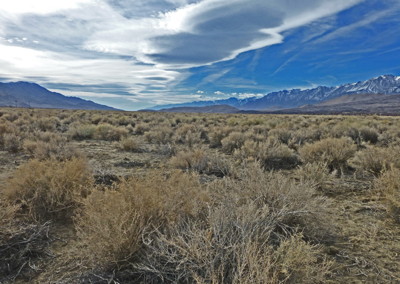
Shadscale Scrub in the Eastern Sierra, photo by Tom Heindel
Deserts occur worldwide and all the wildlife that lives in these deserts faces similar challenges. Basically, deserts are areas with little rain, high evaporation rates, hot and windy summers, cold and windy winters, little open water, limited food, and sparse vegetation. Each biome and the habitats contained within it pose advantages and challenges for the wildlife and plants that live there. Much of the Eastern Sierra region is desert, Great Basin and Mojave types, and its wildlife has had to adapt to some demanding conditions.
All plants and animals require water for life and the very business of living uses up water within the organism and more is needed to replace it. Animals lose water three ways: via respiration when breathing, via excretion in urine and feces, and cutaneously through the skin. It is critical that water intake equals water loss and if it doesn't, the plant or animal weakens and dies.

Verdin in mesquite in a desert oasis, Photo by Tom Heindel
The first strategy of animals is to drink water if surface water is available. In the western parts of Mono and Inyo Counties, there is an abundance of water in the Owens River, lakes, reservoirs and ponds but to the east water becomes more scarce. In the Great Basin and Mojave deserts, there is little surface water and the best indication that water is near is vegetation. Some birds can fly to an oasis, spring, or seep, and often flocks of Lesser Goldfinches, Mourning Doves, and House Finches can be seen flying into a small open water source. Other organisms like some insects, and quail must set up their residence within a short distance of a water supply. Alden Miller, who worked in the Grapevine Mountains along the Inyo County/Nevada border in June 1940, was irritated because he could not find a spring that he knew was there. How did he know it was there if he didn't see it? Because he had seen Mountain Quail and they are never far from a water supply.
Plants and animals have developed a number of strategies to get water. Some plants store excess water in their roots, stems, and leaves for times when the ground is dry and some animals can absorb water directly from the plants or insects they eat or they can produce metabolic water from the breakdown of the seeds they have eaten. Kangaroo Rats produce all the water they need from the seeds they eat; a gram of dry food may produce 0.6 grams of water.
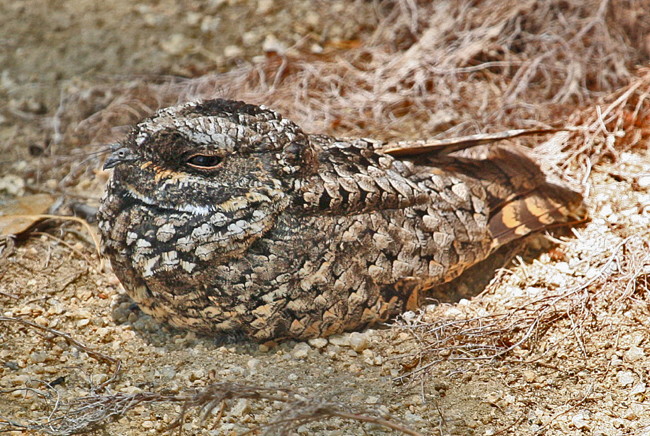
Common Poorwills hibernate to beat the cold, photo by Kelli Heindel-Levinson
A second challenge for animals is temperature, both high and low. Optimal temperatures for metabolic processes are high. In mammals, the range is 97–99°F and in birds 104–108°F. These are just a few degrees below the lethal level for some tissues. Birds have developed several strategies to cope with desert temperatures. First is avoidance, by migrating north or south or choosing routes or times to avoid extreme temperatures, or by moving higher into the mountains to cool down, or by descending the mountains to the valleys to gain warmth. Another strategy is to hibernate like the Common Poorwill, or to enter torpor like some swifts and hummingbirds do to avoid the cold, or to build roosting nests lined with feathers like Verdins and Cactus Wrens, or to roost in tree trunks or cavities like woodpeckers, titmice, and small owls.

Desert Larks sitting in the shade in Saudi Arabia
Photo by Tom Heindel
On a daily basis during the summer, another set of strategies are in effect to avoid the heat of mid day. Many birds become less active and often can be found sitting in the shade with their beaks open or panting to promote evaporative cooling. Some animals have adopted crepuscular or nocturnal patterns of activity to avoid the heat such as many different mammal species and a few bird species, like owls and nightjars. Say's Phoebes often choose a nest site on a shaded cliff face and Burrowing Owls and mammals seek subterranean burrows that remain comfortable on the hottest of days. Vultures may urinate on their legs to promote evaporative cooling and Gambel's Quail may dilate blood vessels in their unfeathered legs to promote conduction of body heat to the outside.

Ash-throated Flycatcher finding a meal
Photo by Kelli Heindel-Levinson
Because water is scarce in the desert, so too is vegetation. This translates into fewer food supplies for the wildlife that inhabits this biome and less cover available in which to hide to avoid detection by predators. The reduced vegetative cover limits the amount of biomass that invertebrates and others can rely on for food. This results in fewer invertebrates for vertebrates to devour which results in fewer vertebrates and fierce competition between the few vertebrates who live in the desert for the few resources available. Birds and mammals are on constant alert for danger. Those who let their guard down are usually quickly taken down themselves. When they detect a predator they usually freeze and remain silent and those with cryptically colored or patterned plumage or pelage blend in with their surroundings and, if they don't lose their nerve and move, usually live for another day.
Human visitors can use these strategies to enhance their desert wildlife experiences by spending time in the early morning or late afternoon hours, near water, sitting quietly in the shade. Keep a camera ready!
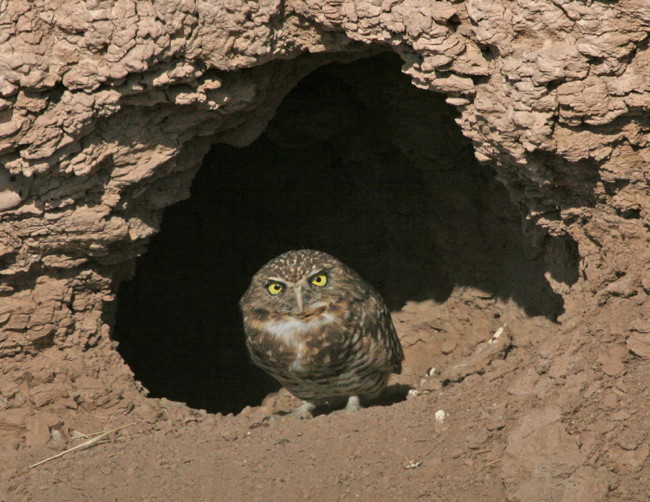
Burrowing Owl staying cool underground - photo by Jo Heindel
Back to Top
Good Places to Go Birding
A new series to share some favorite birding spots, by Debby Parker
Upper Deadman Creek - a Summer Birding Escape
[Click on any photo or link to see a slideshow]
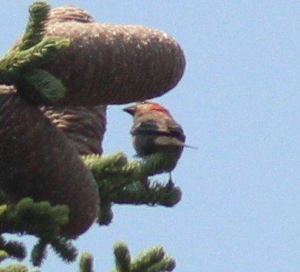
Male Pine Grosbeak atop a Red Fir
Upper Deadman Drainage, photo by Debby Parker
We have many choices for beautiful forest hikes in the Eastern Sierra. When the summer heat hits, it’s the perfect time to leave the sweltering valley behind and drive up to the mountains for a walk in a dark cool forest along a trail of mixed conifers.
Jim and I day-hiked a favorite trail in Upper Deadman drainage last July 2013 looking for some special birds that live and nest in this scarcer-type of habitat in the eastern Sierra, which has many attributes of an old growth forest. We walked under towering Red and White Firs, Jeffrey and Lodgepole Pines and Western Hemlock. We followed the trail up a shady volcanic hill with the pungent smell of Labrador tea growing on the hillsides and wafting through the air. We were often looking high up into these trees trying to find the birds we could hear singing.
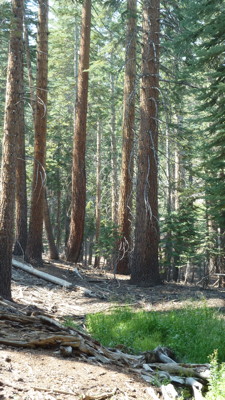
Upper Deadman Drainage with Springs
Photo by Debby Parker
We were looking for Pine Grosbeaks, rarer woodpeckers (Williamson’s Sapsucker, White-headed Woodpeckers, and Black-backed Woodpeckers), Red Crossbills, and others that nest in this habitat. We found most of these, and I managed a few photos of the Pine Grosbeaks, which tend to stay very high eating fir-cone seeds toward the tree tops. Near the spring we had a Black-backed Woodpecker which is the very spot where I had my life bird in 1992 while working for the Forest Service. We also had a White-headed Woodpecker. It’s good to know they are both still there. Western Wood-pewees, Brown Creepers, and Red-breasted and White-breasted Nuthatches were using the forest too. Townsend’s Solitaires are in here too, probably nesting on the ground along with Dark-eyed Juncos. We saw many juvenile Chipping Sparrows indicating they probably nest here also. The trickling springs were adorned with wildflowers, and from the scat on the ground near the springs, bear like this spot too.
Here are directions to the spot (note that Google Maps seem to be off with their road numbers):
Turn west from Hwy 395 about one mile north from the Crestview Rest Area onto unpaved Deadman Creek Road (Forest Road 2S05). Travel approximately 4-5 miles total and you will come to Lower Deadman Creek Campground and creek crossing. Just beyond is a large clear sign on the right (north) side designating Obsidian Group Campground turnoff. Don't turn here, but continue straight for less than 1/4 mile to another right hand turn (north) that is probably marked 2S50 & says "DEAD END." Drive in a short way and park where convenient. This road is a jeep road and best for walking. Follow it for approximately one mile as it winds up through the old-growth type forest until you get to a closed road on left (west) of road. This is fairly obvious. The springs are in the trees and might take a little searching.
Dogs should be on a leash so as not to interrupt nesting birds, fawns, or other wildlife.
Debby Parker
Back to Top
Reports / Announcements
Birds in the Classroom - Call for Volunteers
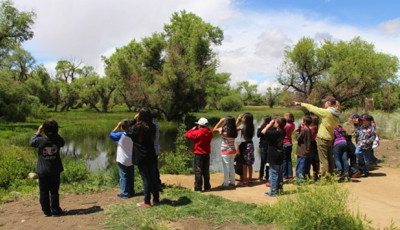
Third Grade Field Trip to the COSA
Part of the Birds in the Classroom Program
Spring is in the air and it’s time again for Birds in the Classroom, the program that is, as one former board member put it, “The most important thing our chapter does”! It is quite an accomplishment that our small chapter makes sure that every third grader in Bishop gets a very thorough and very fun introduction to birds and birdwatching. And it is because we have wonderful volunteers who love birds and want to hang out with kids who love birds! Here is our call for volunteers:
Eastern Sierra Audubon PowerPoint classroom presentations will be on April 22nd, 23rd, and 24th - let us know if you are interested in helping with these fun presentations.
Birding Field Trips to the Tribe’s Conservation Open Space Area (COSA) will be 3 days during the week of May 12, with the exact dates depending on volunteer availability. If you've never done this before, this is how it works: the students are taught birding etiquette and how to use binoculars in class before the trip. On the day of, you lead about 5 students around the area looking for birds. You help them find birds and try to identify them, and just have fun birding. The first class of each day will be from 8:30- 9:30am, and the second class from 9:30- 10:30am. You can volunteer for any or all of the 3 days.
We have decided to switch the location of the field trips to the COSA. This way the teachers don’t have to walk their classes across town and they will get to bird in a really amazing birding area right behind the school. Over 75 species of birds have been seen on the COSA!
Please contact Hillary Behr if you are interested in volunteering to lead a small group of students on the birding field trip or are interested in doing the PowerPoint. Thank you! (760) 920- 5287, Hillary.behr@bishoppaiute.org.
Hillary Behr
Back to Top
Calling all Graduating Senior High School Students!
Are you a high school senior (or do you know a senior) who is interested in applying for the Eastern Sierra Audubon Society’s 2014 scholarships? Two, $500 scholarships will be awarded, one to a Mono County and one to an Inyo County senior.
We are looking for someone who has demonstrated through current study and activities and whose future studies, volunteer work and career ambitions will promote the National Audubon Society’s mission:
“To conserve and restore natural ecosystems, focusing on birds, other wildlife and their habitats, for the benefit of humanity and the earth’s biological diversity.”
You can be studying art, science, education, advocacy, habitat conservation, journalism, literature, law, public policy, environmental justice or outdoor recreation (or maybe something we haven’t thought of!) Volunteer work as a student is a plus, but not a requirement. Qualified applicants are required to attend college/higher education full-time starting in Fall 2014-2015. On-line applications are available at: esaudubon.org/education/scholarships/.
We welcome you to apply for this special opportunity and will be accepting applications until Friday May 9, 2014. Deadline has to be strictly enforced so we can meet our deadlines with your school.
For more information, contact Roberta Lagomarsini: 760-872-7846, scholarship@esaudubon.org.
Good Luck!
Roberta Lagomarsini
Back to Top
New T-Shirts Are In! (February 2014)

New black and white design
We have a new order of T-shirts in, including men’s and women's cut, long and short sleeve and purple no sleeve tees. Shirts are available in our original four-color design and our new, cutting edge, white-only printing (photo at right).
Prices: $20.00 for short-sleeved tees, $22.00 for long-sleeved tees, and tanks $15.00 (hurry only 2 left!).
ON SALE – original design tees only $15.00. Get them while they last as we won’t be printing these any more.
All can be found at Spellbinder Books on Main Street (and while you’re there, show your appreciation for their support and buy a book or two)!
Roberta Lagomarsini
Back to Top
Taking Care of Business
Welcome New and Rejoining Members!
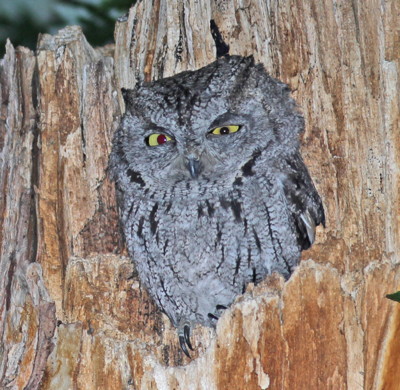
Western Screech Owl, photo by Tom Heindel
Thank you to the members who joined or renewed their membership!
We'd like to take a moment to promote Chapter Memberships: You may not be aware of this, but 100% of Chapter Membership dollars stays locally in the Eastern Sierra, supporting local education, youth, conservation, and programs. If you don't need Audubon Magazine, consider joining or renewing as a Chapter-only member, or better yet, as both Chapter and National! We do get support from National Audubon, as well, so any membership helps, and is money well-spent toward bird and wildlife conservation and education, and we thank you!
Your membership donations help keep this chapter alive. We get 8-10 renewing members a month, and from 3-5 new members. Your membership dues make it possible for us to offer and support great educational and recreational events throughout the eastern Sierra. Thank you!
If you would like to join and help support Eastern Sierra Audubon, there are two ways you can do it:
- Join as a National Audubon Society Member, designating ESAS as your chapter affiliation. Includes Audubon Magazine subscription. This is $20 for the first year, and goes up to $35 annually thereafter.
- Join as an ESAS Chapter-only Member for $20 per year. 100% of your donation stays here in the Eastern Sierra this way. Your chapter membership is a way to give back, and show your appreciation for all that ESAS does, and to help support our mission locally. Your membership helps pay for scholarships, programs, special events, education programs, research, and more. THANK YOU for your support!
Click Here for a membership form to join or renew!
Join National Audubon - your zip code will associate you with the chapter nearest you.
Back to Top
How You Can Help ESAS: Four R’s (and a V)
Renew your membership (or join): The money from your membership dues is what helps us bring great evening programs, special events, - educational programs, trips, this website, and more to the community - we need your support!
Recycle at Manor Market and tell them to donate the money to Eastern Sierra Audubon.
Respect property and get permission to bird on private or restricted access property.
Repeat: Spread the word about programs and events, encourage others to join and participate.
Volunteer: Come to a board meeting and consider volunteering for an open board position! We welcome new board members, and we also always need volunteers for Birds in the Classroom, participants in bird counts, Bird-A-Thons, etc.
Message from the Editor
Our next newsletter deadline will be April 15th for the
May-June issue, and of course you are always welcome to send submissions for future newsletters
and also the monthly email at any time.
We send out about one email each month to remind you of upcoming events - if you are not
on our email list, please
add yourself so you don’t miss anything!
If you send items to the newsletter
editor by the last week of any month, we’ll make sure they get included in
the next issue.
All of our content is supplied by our awesome members... if you have any ideas about articles you’d like to see, or better yet, if you have anything to share for newsletter publication, whether an article, a news item, update, correction, poem, essay, artwork, photo, field trip report, neat birding experience, letter, etc, please send it, along with any comments or suggestions, to the newsletter
editor. We’d love to hear from you!
You may send items for inclusion in the newsletter at any time, but please
send any timely items to arrive before the first of the month, so they can
be included in the monthly email update.
Thanks for reading, and happy birding!
Maggie Wolfe Riley, Newsletter Editor
Back to Top
Calendar for January-February
- Field Trip: COSA Bird Walk and Census, Saturday, March 8th
- Field Trip: COSA Bird Walk and Census, Saturday, April 12th
- Deadline for March-April Newsletter Submissions: Tuesday, April 15th
- Registration for Mono Basin Bird Chautauqua opens: Tuesday, April 15th
- Owens Lake Spring Big Day: Wednesday, April 23rd
- Program: April Program: Kern County Big Year, THURSDAY, April 24th
- Audubon Yard Sale: Saturday, April 26th
- Field Trip: Mammoth Creek Birding: Saturday, May 17th
Back to Top
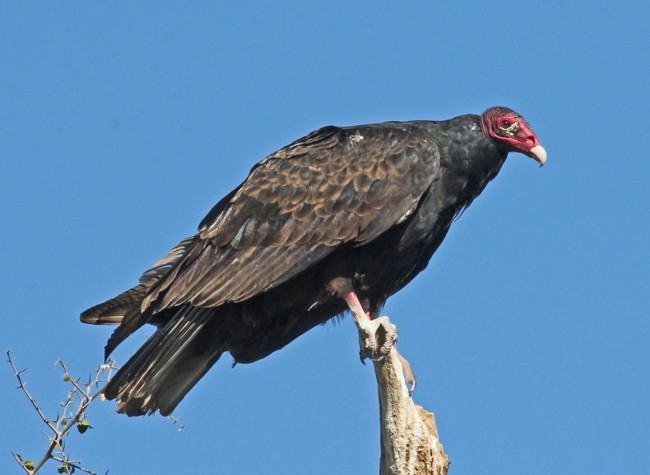
The best kind of "TV" to watch - Turkey Vulture, photo by Tom Heindel
Back to Top























